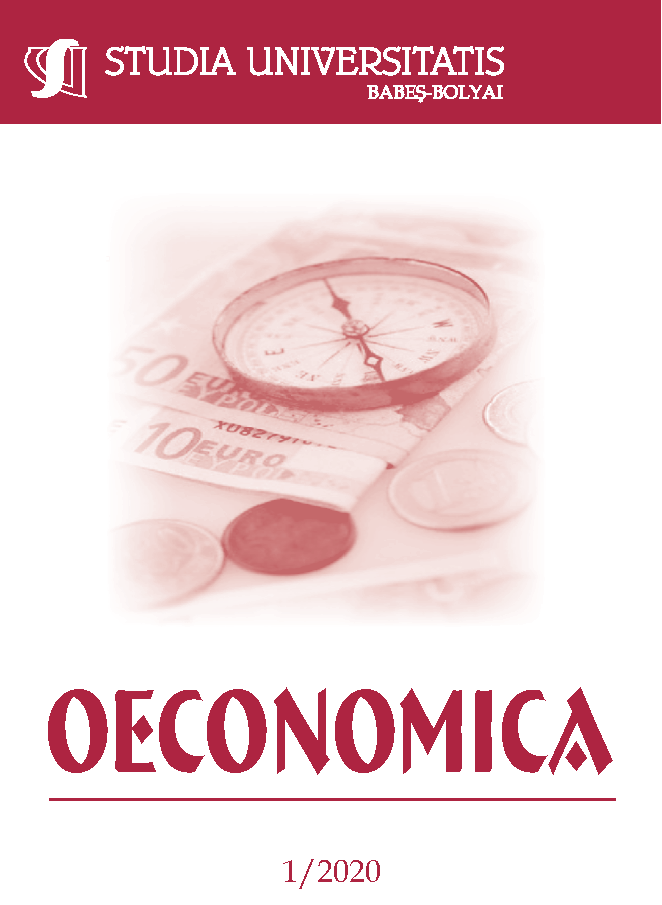MILITARY EXPENDITURE AND MACROECONOMIC PERFROMANCE – THE CASE OF AN EMERGING COUNTRY
DOI:
https://doi.org/10.2478/subboec-2020-0005Keywords:
Output. Military Expenditure, Exchange rate and Inflation rateAbstract
The study investigates the nexus between military expenditure and macroeconomic performance in Nigeria between 1980 and 2017. Data on military expenditure and some macroeconomic variables such as output (GDP), exchange rate and inflation rate are used in the study. The Vector Auto-regression technique VAR is applied so as to study the interactions among the variables in the short run. The result shows that military expenditure in Nigeria is significantly influenced by output and exchange rate shocks. It was also revealed that military expenditure does not make significant contributions to the behaviour of output in Nigeria. Military expenditure appears to be insulated against inflation shock since the largest chunk of military expenditure is traded in foreign currency hence less affected by domestic prices.
JEL classification: H19, H50, E00, E02;
References
Abbas, S., & Wizarat, S. (2018). Military expenditure and external debt in South Asia: A panel data analysis. Peace Economics, Peace Science and Public Policy, 24(3).
Ali, H. E., & Solarin, S. A. (2019). Military spending, corruption, and the welfare consequences. Defence and Peace Economics, 1-15.
Anifowose, O. L., Adeleke, O., & Mukorera, S. (2019). Determinants for BRICs Countries Military Expenditure. Acta Universitatis Danubius. Œconomica, 15(4).
Atesoglu, H. S. (2002). Defense Spending Promotes Aggregate Output in the United States--Evidence from Cointegration Analysis. Defence and Peace Economics, 13(1), 55-60.
Cheng, M. K. C. (2006). A VAR analysis of Kenya's monetary policy transmission mechanism: how does the central bank's REPO rate affect the economy? : International Monetary Fund.
Deger, S. (1986). Military expenditure in Third World countries: the economic effects: Taylor & Francis.
Faini, R., Annez, P., & Taylor, L. (1984). Defense spending, economic structure, and growth: Evidence among countries and over time. Economic development and cultural change, 32(3), 487-498.
Feder, G. (1983). On exports and economic growth. Journal of development economics, 12(1-2), 59-73.
Furuoka, F., Oishi, M., Karim, M. A. J. D., & Economics, P. (2016). Military expenditure and economic development in China: an empirical inquiry. 27(1), 137-160.
Galvin, H. (2003). The impact of defence spending on the economic growth of developing countries: a cross-section study. Defence and Peace Economics, 14(1), 51-59.
Kentor, J., & Kick, E. (2008). Bringing the military back in: Military expenditures and economic growth 1990 to 2003. Journal of World-Systems Research, 14(2), 142-172.
Keynes, J. M. (2016). General theory of employment, interest and money: Atlantic Publishers & Dist.
Khalid, U., Okafor, L. E., & Aziz, N. (2019). Armed conflict, military expenditure and international tourism. Tourism Economics, 1354816619851404.
Knight, M., Loayza, N., & Villanueva, D. (1996). The peace dividend: military spending cuts and economic growth. Staff papers, 43(1), 1-37.
Meng, B., Lucyshyn, W., Li, X. J. D., & Economics, P. (2015). Defense expenditure and income inequality: evidence on co-integration and causality for China. 26(3), 327-339.
Mordi, C. N., & Adebiyi, M. A. (2010). The asymmetric effects of oil price shocks on output and prices in Nigeria using a structural VAR model. Economic and Financial Review, 48(1), 1-32.
Nnanna, O. J. (2002). Monetary policy and exchange rate stability in Nigeria.
Odehnal, J. (2015). Military expenditures and free-riding in NATO. Peace Economics, Peace Science and Public Policy, 21(4), 479-487.
Reitschuler, G., & Loening, J. L. (2005). Modeling the defense-growth nexus in Guatemala. World development, 33(3), 513-526.
Saba, C. S., & Ngepah, N. (2019). A cross-regional analysis of military expenditure, state fragility and economic growth in Africa. Quality & Quantity, 53(6), 2885-2915.
Sezgin, S. (2001). An empirical analysis of turkey's defence‐growth relationships with a multi‐equation model (1956–1994). Defence and Peace Economics, 12(1), 69-86.
Shahbaz, M., & Shabbir, M. S. (2012). Military spending and economic growth in Pakistan: New evidence from rolling window approach. Economic Research-Ekonomska Istraživanja, 25(1), 119-131.
Smith, J. S., Tuttle, M. J. D. (2008). Does defense spending really promote aggregate output in the United States? , 19(6), 435-447.
Svensson, L. E. (2002). A reform of the Eurosystem’s monetary-policy strategy is increasingly urgent. unpublished (available at www. princeton. edu/~ svensson).
UNICEF, W. (2018). WHO, World Bank Group. 2017. Levels and trends in child malnutrition.
Wijeweera, A., & Webb, M. J. (2011). Military spending and economic growth in South Asia: A panel data analysis. Defence and Peace Economics, 22(5), 545-554.
Yildirim, J., & Öcal, N. (2016). Military expenditures, economic growth and spatial spillovers. Defence and Peace Economics, 27(1), 87-104.
Yildirim, J., Sezgin, S., & Öcal, N. (2005). Military expenditure and economic growth in Middle Eastern countries: a dynamic panel data analysis. Defence and Peace Economics, 16(4), 283-295.
Zhang, Y., Liu, X., Xu, J., & Wang, R. (2017). Does military spending promote social welfare? A comparative analysis of the BRICS and G7 countries. Defence and peace economics, 28(6), 686-702.
Zhao, L., Zhao, L., & Chen, B.-F. (2015). The interrelationship between defence spending, public expenditures and economic growth: evidence from China. Defence and peace economics, 1-16.
Downloads
Published
How to Cite
Issue
Section
License
Copyright (c) 2020 Studia Universitatis Babeș-Bolyai Oeconomica

This work is licensed under a Creative Commons Attribution-NonCommercial-NoDerivatives 4.0 International License.






